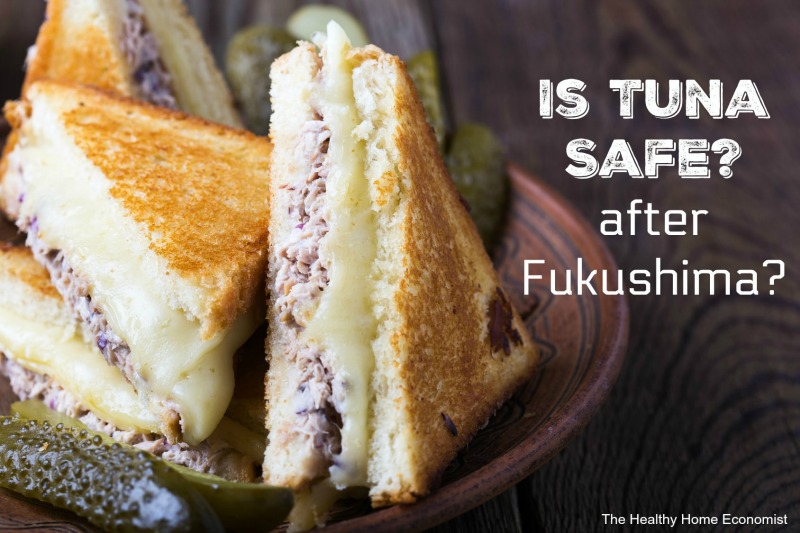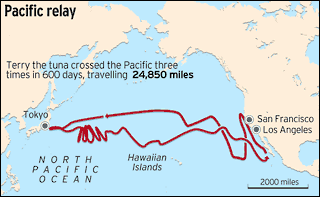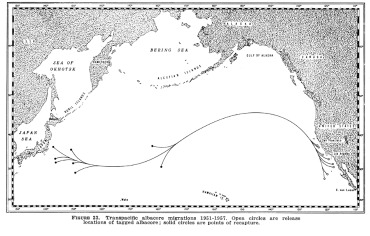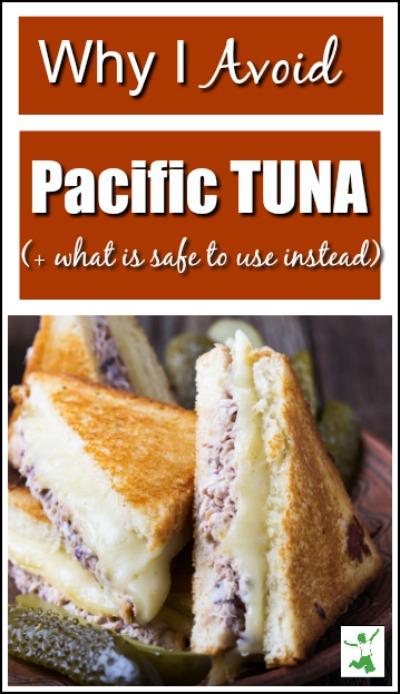
Tuna has always been a staple Real Food in our home. I’ve always taken care to source low mercury, sustainably caught tuna in order to prepare quality tuna steaks for dinner, tuna melts for lunch, or that old standby tuna salad for lunch boxes, quick snacks or just a dollop on a bed of greens. Spicy bluefin tuna rolls are a favorite of my husband when dining at Japanese restaurants.
About a year ago, however, I started to question my choice of tuna for regular consumption. I began reading the reports about the spreading radiation plume in the Pacific from the continuing Fukushima nuclear disaster. I delved into the migratory patterns of various species of tuna. The more I read, the more concerned, and quite frankly, confused I became.
Realizing that my family’s health can’t be wagered on guesses or half-truths, I gathered as much information as I could to arrive at an informed decision. Here’s what I found.
All species of tuna are highly migratory. This means that they swim long distances pretty much throughout their entire lives. These migration patterns are still ill-understood although it is generally agreed upon that they are large.

Pacific bluefin tuna are born near Japan spending their early months swimming in the radiation plume there. They then swim back and forth across the Pacific their entire lives. One tuna nicknamed Terry crossed the Pacific no less than 3 times in the span of only 20 months coming very close to Japan each time. To the right is a chart showing his epic swim.
The information gleaned from Terry the tuna is not new. As early as the 1950’s, tagged albacore tuna were known to swim thousands of miles as shown in this second chart to the right. The open circles off the California coast indicate where they were released and the solid circles closer to Japan indicates where they were recaptured.
 Highly migratory indeed!
Highly migratory indeed!
Atlantic based tuna exhibit the same nomadic patterns. According to National Geographic, high tech tags of Atlantic bluefin tuna revealed the following:
A team of international scientists documented two giant bluefins tagged within minutes of each other off the coast of Ireland. The two fish swam to opposite sides of the Atlantic Ocean–ending up more than 3,000 miles (5,000 kilometers) apart. One of the fish traveled 3,730 miles (6,000 kilometers) southwest to waters about 186 miles (300 kilometers) northeast of Cuba. The other remained in the eastern Atlantic and moved off the coasts of Portugal.
According to the Food and Agriculture Organization of the United Nation (FAO)s, all species of tuna, not just bluefin and albacore, are considered highly migratory, again with the reasons for these patterns not well understood. Here is a breakdown of the tuna species and where they are located according to a report by the FAO:
- Albacore tuna (Thunnus alalunga), which occurs in tropical and temperate waters worldwide.
- Bluefin tuna (Thunnus thynnus), mostly found in temperate waters of the Atlantic, including the Mediterranean, and Pacific Oceans. It is noted that since the adoption of UNCLOS, bluefin tuna in the northern Pacific has been identified as a different species, Pacific bluefin tuna (Thunnus orientalis) while bluefin in the Atlantic has been re-named Atlantic bluefin tuna.
- Bigeye tuna (Thunnus obesus), found in the Atlantic (but absent from the Mediterranean), Indian and Pacific Oceans.
- Skipjack tuna (Katsuwonus pelamis) with a worldwide distribution in tropical and temperate waters.
- Yellowfin tuna (Thunnus albacares), also with a worldwide distribution in tropical and sub-tropical more temperate seas, but absent from the Mediterranean.
- Blackfin tuna (Thunnus atlanticus) found in the western Atlantic in tropical and warm seas.
- Little tuna (Euthynnus alleteratus and E. affinis), with E. alleteratus found in tropical and subtropical waters of the Atlantic, including the Mediterranean, the Black Sea, the Caribbean Sea and the Gulf of Mexico, and E. affinis in the Indian and Pacific Oceans. It is noted that presently, E. alleteratus is called little tunny and E. affinis is called kawakawa.
- Southern bluefin tuna (Thunnus maccoyii), in temperate waters of the southern hemisphere in the Atlantic, Indian and Pacific Oceans.
- Frigate and bullet tuna (Auxis thazard and A. rochei) found in the Atlantic (including the Mediterranean Sea where only A. rochei is found), Indian and Pacific Oceans.
So Tuna Swim. A Lot. So What?
The fact that tuna swim great distances, constantly moving and migrating means that tuna in the Pacific more than likely will have passed through the growing Fukushima radiation plume at some point in their lives, probably numerous times.
With long-lived varieties like albacore (11-12 years) and bluefin (up to 20 years), this is especially true. With much smaller, shorter-lived tuna like the skipjack (about 8 years), less so.
Is the Fukushima Radiation Even Really a Problem?
The answer to this question depends on who you ask. Some reports say yes, the Pacific-based radiation plume from Fukushima is a serious problem and growing worse as 300 tons of radioactive water pours into the Pacific every single day with no end in sight for years. Unbelievably, Japan’s government only acknowledged the urgency of the situation in September 2013.
On the other hand, a comprehensive assessment by the World Health Organization (WHO) concluded that radioactive particles that are making their way to North American waters will have a limited effect on human health, with concentrations below WHO safety levels.
The most unsettling data to date is that the continued outflow of radioactive water from Fukushima now no longer just contains cesium isotopes. It now also contains the more worrisome strontium-90 which is a bone-seeking isotope.
Who is right? Who is wrong?
One thing is true, Fukushima is a nuclear disaster never before experienced in human history so all theories and probabilities are on the table.
Dr. Ken Buessler, a world expert in marine radioactivity with the Woods Hole Oceanographic Institution in Massachusetts who is leading an international research team tracking Fukushima’s trails in the Pacific has this to say:
We still don’t know the answers to many important questions concerning the impacts of Fukushima radionuclides on the oceans. For example, we still don’t have a good handle on how much radioactivity was released, and we don’t fully understand where it has ended up, and that holds for the ocean waters, seafloor sediments, and for marine biota, such as tuna.
Caution Seems to Be the Best Policy
Having personally known someone who died of radiation-induced cancer 15 years after the Chernobyl disaster from the fallout that blanketed parts of Europe which governments at the time said was no threat to human health (his wife lost most of her hair but has survived although they tragically had a daughter born a few years after the disaster who developed leukemia), I don’t take the long term, cumulative effects of radiation lightly and interpret official reports like the one published by the WHO with a grain of salt.
If you choose to interpret the data as a nonthreat to human health with the radiation levels within safe limits, that is, of course, your choice. My approach is both practical and cautionary to play it safe for my children’s sake until more information is gathered and the extent of the problem studied further. This includes avoiding all tuna from Pacific waters given that this particular migratory fish is prone to swimming close to Japan multiple times during its lifetime.
Since much of the time, the ocean of origin for tuna is unknown or not labeled, this would mean avoiding all tuna in most cases. This is exactly what I’ve been doing for the past six months or so – no tuna in my home. Period.
The complaining of my family about the absence of tuna dishes (which everyone loves) has caused me to continue to search for a source of tuna I would feel comfortable serving. I recently discovered a skipjack tuna from Portugal (source) that I’ve been purchasing for several years.
Buy Atlantic Based Tuna!
Given that Atlantic based tuna do not enter the Pacific during their lives, I felt at this time, this brand of sustainably-fished Atlantic tuna would be safe to eat.
However, predictions are for the Fukushima radiation plume to continue growing, eventually entering the Arctic and then the Atlantic Oceans, as the disaster is far from contained. As a result, this situation most likely will change in the coming years. For now, however, if tuna origin can be accurately confirmed, I will purchase and eat it – but only from the Atlantic Ocean and other non-Pacific sources.
What are your thoughts about eating tuna and other seafood? What data have you come across to support your decision? Do you continue to eat tuna? Why or why not?

References
(1) Radiation From Fukushima Could Help Solve the Mystery of Bluefin Tuna Migration
(2) Health risk assessment from the nuclear accident after the 2011 Great East Japan earthquake and tsunami, based on a preliminary dose estimation
(3) Tagged Tuna Reveal Migration Secrets
(4) Tuna’s 25,000 Mile Swim Down Marine Highway
(5) The Migration, Age, and Growth of Pacific Albacore (1951-1958)
(6) Should you Worry about Radiation in your Wild Pacific Fish?
(7) Highly Migratory Species of Fish
(8) Tuna Species








Thanks for all that researched info abt tuna. Ive been wondering about that for a long while. Very helpful.
Tragic and angering. Especially that this disaster happened over 3 years ago and a solution to the continued flow of radioactivity into a world-shared waterway is not a top concern of ALL global leaders. Yes, we still eat tuna – but it is more like 4 or 5 times a year rather than regular fare…
Thanks for the info. Trader Joes carries skipjack tuna.
What about sardines?
Didn’t see the comment I left, so I’m going to try to post is again. Hope I’m not double posting. 🙂
——————————————————————————
The author missed is a very important point: bio-accumlation
The higher a fish is on the food chain, the higher the amount of toxins it accumulates. All sea biota get exposed to an similar levels of ambient pollutants but when a little fish eats sea weed, it will have more toxins because it is ingesting them through its dietary intact. When a bigger fish eats the smaller fish, the amount of toxins multiple and when a bigger one eats that one, it gets multiplied again. So on and so forth until you get to tuna and swordfish which pretty huge. The life span and feeding habits of the biota also impact the amount of pollutants it will accumulate during its life.
A 1990-2010 USDA study on the mercury levels found in commercial fish found that sardines and tilapia had 0.013PPM of Hg, Salmon had 0.022PPM whereas Tuna can have any from 0.128 to 0.689PPM (depending on the variety). Meaning the levels of mercury are multiplied by a factor of 10 to 53 times compared to that of tilapia or sardines or 5 to 17 times the levels of those found in Salmon. A link to the study in question was attached to the comment.
It’s same principles for how much radiation tuna absorb. Tuna is definitely a higher risk group.
What about the fact that skipjack tuna are fished at a younger age than other tunas? Does that help with this factor?
Instead of speculating about how tuna might be affected, why don’t they just measure the amount of radioactivity–if any–that is actually present in the meat and/or bones of samples of tuna. Then we would know for sure. Odd that no-one has taken such a simple step. Or maybe they have and are keeping the findings quiet. Also, if tune are affected, wouldn’t Alaskan cod also be affected, since the Japanese current flows up the Asian coast to Alaska and then down our Pacific Coast as the Alaskan current. Interesting that Trader Joe’s stopped selling Pacific Ahi tuna filets several months ago without any explanation, and has just now started reselling Ahi tuna from off the coast of Spain. And by the way, how about the thousands of tons of pesticides that flow down American rivers into both the world’s oceans.
I second RIchard’s suggestion. If you are concerned about radiation in your food, then get a Geiger counter and test it. That is likely to get you far closer to the truth than speculation about where your supper went on vacation and for how long.
Great suggestion, but personally I’m not going to spend the money to purchase tuna only to chance having to waste that money if the test is positive for radiation. It would be much better if it was done by the company selling the tuna or the fisherman catching it and create a label similar to certified organic.
Can you really test food that you buy with a geiger counter?? If so I will definitely be buying one. I’ve heard that the radiation is also in grass & rice & beans……and I have definitely noticed a change in the taste of beans since the fukushima incident…..
Who is the “they” that you are willing to trust with your life?
The government? The tuna/fishing industry? The WHO? Or how about any or all of the various Nuclear Power agencies? They would certainly tell us the truth, eh? The U.N.? As a human, you’re allowed a bit of naivety… But if you show up at your local seafood market or grocery store with a geiger counter, be prepare to be escorted out – probably by the police.
just carry it up your sleeve , now why didn’t you think of that ? lol !!!!
They shut down the radiation monitoring equipment on the West Coast of Canada and the USA right after the crisis. Then the EPA raised the amount of radiation you could be exposed to safely. The WHO and CDC never investigates nuclear accidents to my knowledge because that falls under the juristiction of the IAEA. Someone on here mentioned that tuna that was sourced from the Atlantic going to Britain now is being sourced from the Pacific and is much cheaper (ie: smaller demand for it). Someone also mentioned that Trader Joe’s stopped sourcing tuna from the pacific and is now getting it from the Atlantic. They will never monitor radiation in fish from the Pacific because they know its there. And I wouldn’t believe them anyway (Maybe if they took a sample, showed the readings and then proceeded to gorge themselves on it – I still wouldn’t believe them actually – just be watching their careers until the cancer shows up sometime later). All these thing point to the Pacific being totally poisoned.
Cs134 and Cs137 are two isotopes which didn’t exist in nature until the nuclear bomb tests in the 1950’s, I’ve heard. But make no mistake, Fukushima is not releasing ONLY these two plus I-121 into the ocean, but many others as well (probably radioactive Xenon, Strontium 90, etc). The IAEA protocols only deal with external doses of radiation. They never talk about what happens when this stuff is ingested. Thats what causes cancer in the long term, not necessarily right now. What will smaller doses (than background radiation) of Cs134 or 137 do to you? Nobody knows because we haven’t had to contend with it before, or if we have, the IAEA keeps it to themselves. Cs137 seeks out heart muscle. I expect to see a lot more heart attacks in the future. So I don’t want to take any chance on that stuff. I’ve given up eating ANYTHING from the Pacific or the West side of the country.
Chris Busby talks about “internal emitters” on youtube a lot. He is always put down by the IAEA and people who don’t want to hear the truth, but what if he’s right? I believe millions died or are in the process of dying (the “liquidators”, for ex) from Chernobyl. Many birth defects. But critics will point out that none of this can be proven. I’d like to believe what our leaders tell us but I believe they are lying about the graveness of the situation.
A normal geiger counter, from what I’ve learned, won’t help you detect radiation in fish or other things – unless its very high. (Bionerd23 is a good source of information about such things on youtube). For something like that, you need a scintillation counter which is 100’s of times more sensitive to radiation than a GM tube. One type (NaI), coupled with a computer, can discern discrete energy levels to give you an idea of what the isotope is that you are dealing with. The other type can only tell you there is something present, just not what. I have a geiger counter and I’m working on getting the scintillation detector, first the cheaper one and then the more expensive (NaI) one. A lot of these are in use throughout Japan, I’ve heard, to reassure people about eating the food.
Our EPA could monitor the situation, but they won’t. Nobody is looking out for us but us. I would say to try and source your food from the Atlantic and Eastern side of the USA as much as possible. And keep researching about what is going on outside of mainstream news. They can’t say anything without putting some “spin” on it.
This is another perspective. Interesting to read: http://www.hiroshimasyndrome.com
The second article in this series discusses the need to immediately establish a
command presence, the importance and challenges of securing a crime scene.
We are your one stop emergency preparedness headquarters.
So, contact the nearest health center today, enroll for the course, and obtain a certificate and start saving lives.
Amazing that people will believe a cook over a scientist that is showing where and how his data is obtained.
You have more chance of a drunk driver or a texting/cellphone using driver killing you and your entire family than suffering from eating tuna that MAY have visited the waters off Japan.